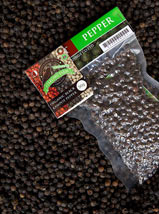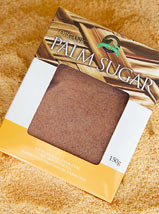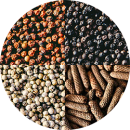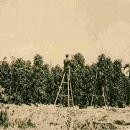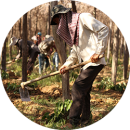We grow organic
All our pepper is totally organic, grown using only traditional methods. We use no chemical fertilisers or pesticides on our farm. Our fertiliser is a mix of cow manure, bat guana, neem tree mulch and fish meal. Our pepper is dried in the sun for several days prior to being sterilised and vacuum packed so that it reaches you as fresh as it left us.
Ancient & Modern Growing Techniques
The pepper plant is a creeping vine, which in its wild form grows around the trunks of trees. Cultivation today substitutes wooden standards for live tree trunks. At Starling Farm we use a combination of wooden standards and towers made of brick.
No matter what technique is used, each pole or tower will have a small shallow dug around its base to concentrate the water and natural fertiliser used, and will have from three to eight plants planted around, which take three years to grow to maturity and start producing high quality pepper.
Traditional Wooden Poles
Continuing Ancient Pepper Cultivation Techniques
Continuing Traditional Methods
The pepper plant is a creeping vine, which in its wild form grows around the trunks of trees. Cultivation today substitutes wooden standards for live tree trunks. At Starling Farm we continue the tradition of using wooden standards as a compliment to our towers made of brick.
Replacing the natural tree trunk with a wooden standard is no new practice, records of pepper cultivation in this manner date back to the 10th century and the height of the Khmer Emire built around Angkor Wat. We continue the traditional practice and methods with hundreds of wooden poles covered in pepper vines right now.
What We Use
Tall wooden poles, typically around 20cm in diametre and 2 to 3 metres in height, are planted in the ground approximately 1.5 to 2 metres apart, often these are connected together to form a semi-rigid structure and give the poles added stability. The added structure can then be used to support protective material – traditionally banana leaves but now often netting to keep birds and bats out as they love to eat the ripe pepper berries before harvest time.
Brick Pepper Towers
Innovative solution to environmental concerns
Cambodia is facing a serious problem of deforestation. Forests are overexploited and wood is subject to intense trafficking. Using thousands of wood poles to grow our pepper, we were concerned by the potential impact it could have on Cambodian environment. This leads us to create an innovative technique in 2008, instead of using wood poles, we have started to build solid brick columns for the pepper vines to grow around. While the wood poles have to be replaced every few years, the bricks will last for ten or twenty years easily, significantly increasing the benefits of the technique. It’s also come up that it allows us to doubled the amount of pepper we could grow per square meter when compared to traditional wooden poles, where we would have two or three plants around a wooden pole, we could have up to eight around a brick column. To date, we have built more than 1300 brick towers.

